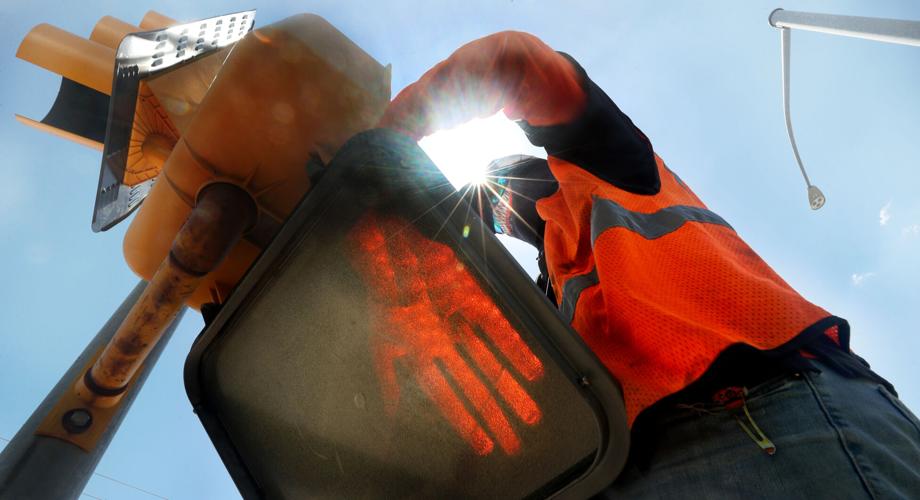The forces of human-caused climate change triggered temperature spikes in both Tucson and Phoenix on well over half the days since our prolonged, record-setting heat wave began in late June, a science group’s analysis found.
At the Star’s request, Climate Central used what it calls a Climate Shift Index to indicate how much climate change boosted each day’s high, low and average temperatures in both cities from June 1 through Thursday, July 20. It found that since June 25 here and June 26 in Phoenix, the impacts of human-caused climate change triggered by fossil fuel burning and other greenhouse gas emissions began in a mild fashion and intensified through last week.
The analysis comes as the heat wave appears to have hit a peak in the past week. Temperatures have stayed stubbornly high for long enough now that this July could surpass the heat of July and August 2020, which have been Tucson’s hottest two months on record, said Aaron Hardin, a National Weather Service meteorologist in Tucson, and Michael Crimmins, a University of Arizona professor and climate scientist.
Moreover, Climate Central’s analysis concluded that despite Phoenix’s notoriously scorching temperatures compared to ours, climate change has spiked Tucson’s temperatures during this heat wave more than Phoenix’s.
In that period, Tucson experienced 10 days in which temperatures topped 110 degrees, while Phoenix had 21 straight days of 110-degree-plus weather — record-setting sprees for both cities.
The capital city’s temperatures peaked at 119 degrees for three straight days ending Thursday. Tucson’s high temperature topped out at 112 those same days.
But the Climate Central analysis found that Tucson actually had more days in which climate change boosted its temperatures than Phoenix did. The difference in climate change impacts between the cities was particularly pronounced at night, when the Climate Central analysis found the strongest climate change effects overall.
That’s even though Phoenix had 11-straight nights ending Thursday when the low temperature never fell below 91; it was 97 on Wednesday night, July 19. Tucson’s lows ranged from 78 to 87 on the days when climate change impacts were found.
The key to why Tucson had more days with high rankings on the climate index “is that we’re talking about how unusual a temperature is for that location and how much we can link to climate change (based on climate models and long-term trends),” said Andrew Pershing, Climate Central’s vice president for science.
“The simplest explanation is that while Phoenix is hotter, Tucson’s temperatures have been more unusual,” Pershing said.
From June 25 through July 20, Tucson’s maximum temperature exceeded its normal high by an average of 7.2 degrees daily. The daily difference in Phoenix averaged 6.7 degrees, Pershing said.
One reason for that could be that in Tucson, average temperatures in July typically decrease more rapidly than they do in Phoenix, which would naturally increase the gaps in the daily differences between current temperatures and normal ones, weather service meteorologist Hardin said. That would happen because Tucson normally gets a lot more monsoon moisture that lowers temperatures than Phoenix typically does, he said.
Also, the most intense area of temperature anomalies in this region has been centered a bit to Tucson’s south and east, in Southwest New Mexico, around the Mexican border, Climate Central’s Pershing added. Overall, Tucson has tended to be closer to the center of the “heat dome” that’s been linked to this heat wave than Phoenix has, Pershing said.
‘This is a monster’
“Heat dome” is a commonly used term for a high pressure ridge that traps summertime heat beneath it, said Erinanne Saffell, Arizona’s state climatologist. One or more heat domes have been elevating temperatures all over the Southwest and Deep South over the past few weeks.
“It causes heat to build up, and with that heat buildup in the desert, it tends to stay here unless it gets pushed off to the north and east and west,” said Dalton Van Stratten, another weather service meteorologist in Tucson. “When the high is directly overhead, especially, and it’s very strong, you get really hot temperatures, a really hot pattern.”
Heat domes are common in this area in the summertime but they typically get pushed to the north and east as monsoon storms move in, said several weather experts. In fact, typically, a heat dome paves the way for the monsoon season.
“It’s the typical progression of our monsoon ridge. It starts in Mexico in May and June and typically builds north over Tucson in June,” said Crimmins, a professor and extension specialist for the University of Arizona’s Department of Environmental Science.
If all is going well weather-wise, the heat dome pushes north and east into the Four Corners area by now, allowing monsoons to roll into this region from Mexico, Crimmins said. But this year, it’s stuck farther south, centered right now over Central Arizona and wobbling at times towards Southern Arizona, he said.
“They are a normal, natural thing. This one is a little bit more extreme, longer lasting, impacting a lot more people than it normally does,” said state climatologist Saffell.
From Climate Central’s Pershing’s perspective, the current heat dome “is just a super remarkable event — the insistence, the persistence of this. This is a monster — really, really scary.”
Climate Central started noticing the heat dome impact in its weather data starting “basically in the middle of June, when we started to see heat in Mexico start to peak,” Pershing said. “Then, there was a three-day break. Then, a new pulse came in, even more intense and bigger,” he said.
It has covered parts of Mexico, California, Utah and Arizona of late — “the fact that these conditions are sticking around for a week is really remarkable,” Pershing said.
Climate Shift Index
Generally, the Climate Shift Index employed by Climate Central examines the difference between a given day’s temperature and its 30-year average temperature for the same day, Pershing said.
“The best way to think of it is that we’re trying to estimate how frequently our current temperature, which is 1.3 degrees Celsius (1.8 degree Fahrenheit) warmer than pre-industrial temperatures, would occur in the current climate. Then, we compare that with the temperature that would happen without human-caused global warming,” Pershing said.
“Think of it as a world without global warming. The last time that happened was around 1900. But we’re not literally saying what the frequency would have been in 1900. We’re literally trying to say what would happen today without global warming.”
The index ranks each day’s temperatures analyzed on a scale of 0 to 5.
A zero means that day’s temperature had a weak or no link to climate change, Pershing said. A 1 score means that day’s temperature is one and one-half times more likely to occur due to climate change. Scores of 2 through 5 mean the day’s temperature was 2 to 5 times more likely to occur because of climate change.
Here’s how those rankings have played out in Tucson and Phoenix from June 25 through Thursday:
— Tucson had 18 days where daytime high temperatures scored at least 1 on the index, and 23 days whose average and overnight low temperatures warranted at least a 1 ranking.
— Phoenix had 15 days whose high temperatures merited at least a 1 score on the Climate Shift Index. It had 19 days whose overnight low was warm enough to warrant at least a 1 score, and 16 days whose average temperature warranted the 1 score.
— In Tucson, no high daytime temperatures were hot enough to deserve a 5 rating, although July 19th and 20th got 4 rankings. But 13 overnight lows earned a 5 ranking from the climate index, including every night since July 9.
— No daytime high temperatures earned a 5 rating in Phoenix and two days also scored 4’s. Ten nighttime low temperatures there got 5 rankings — the last 10 days studied through Thursday.
Big nighttime difference
That nighttime temperatures detected in the two cities during this heat wave were higher compared to normal nighttime temperatures than high temperatures were, compared to normal high temperatures, would come as no surprise to most knowledgeable climate-watchers.
That’s because the urban heat island effect — in which the use of concrete and other forms of hard surfaces on buildings, pavement, sidewalks and the like jacks up nighttime temperatures — often has a bigger effect on the climate than global warming, many experts have said.
But in the current heat wave, the way the data has appeared worldwide “makes me feel very confident there is a strong global warming pattern” affecting the greater nighttime temperature differential from the norm compared to those in the daytime, Pershing said.
“We see this nighttime pattern everywhere around the world, especially within 30 degrees latitude of the equator. You’re pretty close to that in Tucson,” he said. “You’re maybe like 35 degrees. The closer you get to the equator, we get a much stronger climate change signal at nighttime temperatures.”
Still, another factor is that the weather signal is quieter at night than during the day, making it easier to pick up the signal of climate change impacts, he said.
During the day, it a cloud passes over, it cools things down. If it’s not cloudy, that warms things up. But at night, there’s less temperature variability than during the day, he said — “the temperature you get at night is a really good indicator of heat in the system.”
Asked if he saw this summer’s heat wave occurring more in the future, he first referred a reporter to federal government climate assessment reports, then said, “The short answer is more.”
“Every time we look at data for Southwest, especially in the summer, our mouths just hang open,” Pershing said. “The trends there are so strong compared to other places we look at around the country. Every summer, we expect a week or more of intense heat (there). Every year, a week stretches into two, then three. That trend has gone on for two or three years. When you see a trend like that, you’ve got to bet on it continuing.”
‘Highly credible, science-based’
Kathy Jacobs is a University of Arizona professor of environmental science and director of UA’s Center for Climate Adaptation Science and Solutions. While not a climate scientist herself, during the Obama administration she was director of the National Climate Assessment, which analyzed climate change trends across the U.S. She also served on a National Academy of Sciences panel that wrote a 2016 report on the science of attributing extreme weather events to climate change.
On reviewing Climate Central’s findings about Tucson and Phoenix temperatures at the Star’s request, she said: “I was not previously aware of the Climate Central Climate Shift Index, but I think it is a good communication tool. It is a great way to give people an idea of how much the temperature in a particular day is affected by climate change.
“Not having been involved in creating it, I can only assume that they have used standard statistical processes for attribution, which have been developed over the last two decades. They are a highly credible, science-based group.”
“It makes total sense that the index is measuring the influence of climate change against a background of weather data ‘pre-climate change,’” Jacobs added. Since Tucson’s temperatures are normally lower than Phoenix’s, “we can still have significant climate change influence if the actual temperatures are lower.”
The UA’s Crimmins and State Climatologist Saffell said they couldn’t comment on the Climate Shift Index because they lacked time last week to review the detailed methodology used to produce it.
They both said they thought there was a connection between the past months’ extreme heat and climate change, but Crimmins’ support for that link was far stronger than Saffell’s.
“The temperatures observed during this heat wave absolutely have climate change fingerprints on it. If we had a heat wave of this magnitude and pattern 50 years ago, the temperatures wouldn’t reach that level of today’s temperatures,” Crimmins said.

Jose Celaya, an electrician with Next Generation Electrical, installs new traffic control lights at East Bilby Road and South Park Avenue Wednesday during triple-digit heat. Tucson and Phoenix are burning through weather records.
“The (temperature) values are much higher than you normally see in this kind of weather pattern. That is the temperature trend expressing itself everywhere at once — it’s just the overall trend of increasing temperatures in the planet. It makes every heat wave a little bit hotter because of that trend,” he added.
There’s no doubt that this persistent and strong ridge of high pressure has some impact from a warmer atmosphere, Saffell said. But as for simple temperature anomalies, as documented by Climate Center, “I don’t think they can be used exclusively to identify attribution,” she said.
She cited a chart, showing maximum June temperature anomalies for Arizona, that showed the unusual temperatures rotated repeatedly between those that were well above normal and well below normal.
“I’d hesitate to identify attributions from this chart,” she said.
At the same time, however, Saffell noted that recently published research has attributed a stalled jet stream over Greenland to increased warming at high latitudes on the planet and to a continued reduction in long-term snow cover across North America. The research was published this summer in the journal Nature Communications.
Get your morning recap of today's local news and read the full stories here: http://tucne.ws/morning







